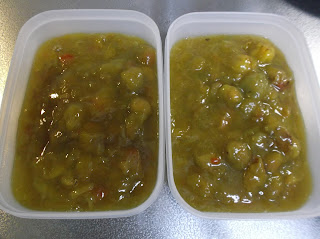Today, I received two boxes of ao (lit. blue, meaning unripe) ume (Japanese apricots or plums) from my father, who lives in Chiba prefecture. Almost 22 kg in total.
今日は、千葉に住む父から青梅を二箱もらいました。全部で22キロ近くです。
I rinsed them with water first.
まずは水洗いしました。
Then, I removed the "heta" from each and every ume, using a bamboo skewer. The time-consuming part of ume syrup/ume jam making. While so doing, I always wonder if I can skip this step...
次に、竹串を使って、梅一つ一つからヘタを取りました。梅シロップ/梅ジャム作りで一番時間がかかる部分です。そうしながら、いつも、省略できないかなあ、と思います。
Because these ume are not store-bought, I have to divide them into three groups: those in good condition, suitable for ume syrup; those with bruises, which I use for ume jam; and those in bad condition, which I have to just throw away.
この梅は市販のものではないので、3つのグループに分ける必要があります: いい状態のもの(梅シロップ用);傷のあるもの(私は梅ジャムに使う);悪い状態のもの(私としては捨てるもの)。
Good ones:
いいやつ:
I rinsed them again, and drained.
再度洗ってから、水を切りました。
Ume for ume jam:
梅ジャム用の梅:
I rinsed them again, and soaked them in water until use.
再度洗ってから、使うまで水に漬けました。
Bad ones:
悪いやつ:
I just threw them away, feeling a little guilty.
ちょっと罪の意識を感じながら、捨てました。
I rinsed the glass jars, four of them in total, with water, and placed them upside down for a while to drain.
ガラス瓶(全部で4つ)は、水洗いして、水を切るため、しばらく逆さにしました。
Then, I dried them. (I used them before they become completely dry.)
次に乾燥させました(完全に乾く前に使いました)。
A common step is to completely dry the inside and sterilize the inside with alcohol. I really don't think this is necessary.
一般的な方法は、完全に内部を乾燥させ、内部をアルコールで消毒することです。私は必要だとは思いませんが。
Another common step is to dry each and every ume with clean cloth. I don't think this is necessary, either.
また一般的な方法は梅一つ一つをきれいな布で拭くことですが、これも私は必要だとは思いません。
I first put 2 kg of the ume in a glass jar with a capacity of 8 liters.
まず、容量8リットルのガラス瓶に梅を2キロ入れました。
Then, I added 1 kg of sugar, shiro zato, to be exact. Rock sugar is usually used to make ume syrup, but I don't want to use it because it's twice as expensive than shiro zato.
次に、砂糖(正確に言うと、白砂糖)を1キロ入れました。 梅シロップを作るには普通、氷砂糖を使いますが、値段が白砂糖の2倍もするので、私は使いたくないです。
I added another 1.5 kg of ume and then 0.5 kg of sugar.
梅を1.5キロ、それから砂糖を0.5キロ入れました。
The ume to sugar ratio is 2 + 1.5 : 1 + 0.5 = 3.5:1.5 = 2.3:1. A common ratio is 1:1.
梅と砂糖の割合は2 + 1.5 : 1 + 0.5 = 3.5:1.5 = 2.3:1です。一般的な割合は1:1です。
After all, I used a total of 11.6 kg of the ume and 4.7 kg of sugar.
結局、全部で梅は11.6キロ、砂糖は4.7キロ使いました。
I put the 2.5 kg of ume in an enameled pot, turned on the gas,
梅2.5キロをホーロー鍋に入れ、火をつけ、
and turned off the gas before the pot came to a boil.
沸騰する前に火を止めました。
Drained.
水を切りました。
I put them back to the pot, added 390 g of sugar (about 15%), and mashed them over very low heat for 2 minute or so.
鍋に戻して、砂糖を390 g(約15%)入れ、ごく弱火で、2分程度潰しました。
I let my wife taste it, and she said it was OK. A common ratio is 1:1, though.
妻に味見してもらうと、OKだと返事。一般的な割合は1:1ですが。
I don't bother to remove the seeds.
わざわざ種は取りません。
I still have 7 kg of ume left. I put 2.5 kg of them in the freezer and the remaining ones in the vegetable compartment of the fridge.
まだ梅は7キロも残っています。2.5キロは冷凍庫に入れ、残りは冷蔵庫の野菜室に入れました。


















2 comments:
How do you like to eat the ume jam? Do you mind sharing photos in an upcoming post?
muskratbyte:
OK, I think I'll post some photos if my wife, who is the major consumer of the ume jam, permits me to take them. I, for one, like to have it with yogurt.
You could be hooked on my ume jam, because it's sweet (but much less sweet than the store-bought kind), sour (well, very sour), and have some "egumi" (no English equivalent, roughly, harshness, bitterness, and astringency).
Post a Comment